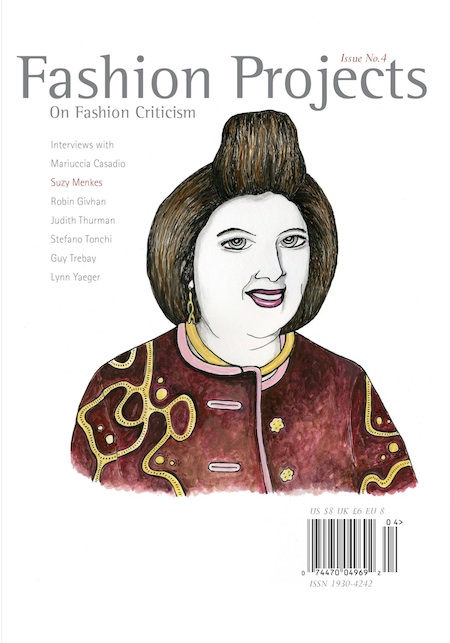Bill Cunningham: Multimedia Man
/by Jay Ruttenberg
For the fourth Fashion Projects print issue (Fashion Projects #4, 2013), Jay Ruttenberg wrote about how Bill Cunningham's work foreshadowed today's multimedia journalism.
Recent years have not exactly been a walk in the park for print journalists, a comically beleaguered species plagued by technological hurdles both real and imagined. Yet of all the indignities the modern newspaperman faces, perhaps the most absurd has been the lunge toward corny multimedia reporting. Publishers love to trumpet their hyperactive ventures into unfamiliar mediums. But from a reader’s perspective, most of this content proves inane. Wading into the website of even the strongest magazine or newspaper can be entering perilous territory: Music journalists natter endlessly over streamed songs. Slideshows tick on interminably, like the unedited vacation photos of a bore. Pasty film critics surface onscreen as if trapped by the light of day. Gifted journalists turn up in wacky videos that can verge on hack comedy routines.
Of course, in rare instances this multimedia content can prove riveting. One suspects that as publications open their ranks to a generation of journalists who came of age under the Internet’s spell, such reporting will flow more naturally alongside its print foundation. In the meantime, readers must make due with sporadic triumphs. And when it comes to the realm of the web extra, few journalist heavies flourish like Bill Cunningham, the famed New York Times fashion photographer.
Cunningham is an unlikely master of this medium. He is in his 80s—a dinosaur even by Times standards—and a suspected Luddite wed to actual film. He is said to have come by his Times web segment, a spinoff of his weekly On the Street article, reluctantly. His bedrock remains the two columns he mans in the Sunday Styles: the print version of On the Street (a patchwork of his street fashion pictures) and, to a lesser extent, Evening Hours (the society photos that encompass his less exciting beat).
On the Street is an unusually whimsical column—among the quirkiest and most personal features in the Times. Both its print and web versions are devoted to the photographs Cunningham takes of women (along with the occasional man or dog) stepping out in Manhattan, generally in parts north. Each column centers around a loose trend that develops in Cunningham’s eye as he putters around town on his bicycle: a sudden wave of plaids, vests, shirtdresses, stripes, young people walking the High Line’s ad hoc catwalk, Upper East Side dowagers who have made bold millinery selections, or women emulating Holly Golightly. In the paper, the pictures run small—he squeezes over 20 shots into half a page—with no captions or IDs. A brief paragraph at the center explains the week’s theme with classic Times sobriety. “Echoes of Ms. Hepburn’s boat necks are reappearing,” the Breakfast at Tiffany’s column states. “One wondered what Holly would look like today.”
The multimedia version of On the Street takes this framework and blows it up. As the same photographs progress in a slideshow, Cunningham speaks of his week’s gleanings in a funny voice juiced with an old Boston accent and the infectious glee of a cultural enthusiast. “Something mahvelous has been happening when I’m out photographing people going to work on Fifth Avenue,” his Holly Golightly segment begins. “I saw young kids leaning against Tiffany’s façade, and they were having breakfast. And I thought, Wait a minute! … Look at these people! They’re reflecting Holly Golightly, 50 year later. It was very curious! And then I started to wonder, Well, what would the present-day Holly Golightly wear?” As the segment ticks on, he posits about a contemporary Holly’s continued affection for black while commenting on the specific looks of select subjects.
The photographer delivers these pieces with a charming off-the- cough air. Apparently, this is no put-on. In Bill Cunningham New York, Richard Press’s fine documentary about the photographer that opened at Film Forum last year, Cunningham is depicted taping his weekly segment. He sits at a table, takes a few seconds to gather his thoughts, and then starts riffing into the microphone in apparent stream of consciousness. Whereas at other points of the movie the photographer is portrayed torturing his designer with painstaking layout decisions and deadline-bending edits, he approaches the online narration nonchalantly, as if he is gossiping with a friend. The effect is wondrous: Suddenly, the website of the world’s greatest news organization appears hijacked by an elderly eccentric, sounding off in a highly idiosyncratic manner about his field of expertise. In discussing his pictures, the photo journalist becomes part professor, part artist, part radio DJ, and part town nut. Digesting the segment is a wholly unique experience.
Perhaps more pertinently, with his web columns the octogenarian achieves a goal that has eluded sundry younger journalists, availing himself of new technological possibilities without abandoning his original print mission or submitting to wanton Internet glitz. Rather, Cunningham uses the web to illuminate—and, arguably, improve upon—his work for the newspaper. The On the Street columns that run in the Sunday Times (and are faithfully archived on the website alongside the videos) speak to the fashion cognoscenti. To readers such as myself, unversed in the trade, their significance can grow fuzzy: What, exactly, unites these photographs? Why does it matter that this hodgepodge of Midtown office-workers are wearing scarves? Aside from the fact that they appear to be loitering outside of Tiffany & Co., how are these women channeling Truman Capote? It is with his web performances that Cunningham draws out the map. Within a few minutes, even a fashion ignoramus fully understands the week’s spread of photographs and is dosed with the photographer’s teeming zeal for his subject. The segment offers the perfect application of a multimedia feature. It is cultural criticism at its absolute finest.









